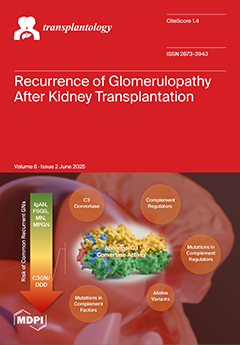Background: Post-transplant lymphoproliferative disorder (PTLD) encompasses an uncommon but wide spectrum of clinical conditions resulting from abnormal lymphoproliferation in patients receiving chronic immunosuppression following organ transplantation. Undoubtedly, reduced immune surveillance of the Epstein–Barr Virus (EBV) is highly implicated in disease pathogenesis. The incidence
[...] Read more.
Background: Post-transplant lymphoproliferative disorder (PTLD) encompasses an uncommon but wide spectrum of clinical conditions resulting from abnormal lymphoproliferation in patients receiving chronic immunosuppression following organ transplantation. Undoubtedly, reduced immune surveillance of the Epstein–Barr Virus (EBV) is highly implicated in disease pathogenesis. The incidence of PTLD varies significantly depending upon the organ transplanted, along with the age and EBV serostatus of the transplant recipient. Some programs advocate the use of routine surveillance for EBV in peripheral blood. In the case of liver transplantation, the incidence, clinical features, and outcomes in adult transplant recipients are poorly described.
Methods: We performed a single centre retrospective study of 1409 individual liver transplant recipients from 20 June 1988 until 31 December 2024, with a view to describing incidence, clinical and histopathologic features, the impact of EBV, and patient outcomes.
Results: There was a 2.0% incidence of PTLD (28 patients). The onset of PTLD was a late clinical event, with a median time of 11.4 (IQR 3.4–6.2) years from transplantation to diagnosis. Most cases were monomorphic PTLD of the diffuse large B cell lymphoma (DLBCL) histologic subtype (85.2%), and the bowel was the most involved organ. EBV was detectable within the tumour in only 52% and within peripheral blood in only 61.5%. Whilst the presence of EBV did not appear to influence the outcome, those patients who were EBV naive at time of transplant, and received an EBV-positive graft, developed PTLD at a significantly earlier post-transplant stage (0.9 years, IQR 0.3–5.8, vs. 11.1 years, IQR 5.5–1.43,
p = 0.02). The type of immunosuppression used did not influence the outcome. In addition, 50% of the patients with PTLD died during the study period, at a median of 0.6 (IQR 0.2–2.6) years from disease diagnosis.
Conclusions: PTLD remains uncommon in the adult liver transplant population and is usually a late clinical event, with EBV detectable in peripheral blood in only 61.5% of cases. Whilst advocated in some units, routine screening for EBV in peripheral blood is unlikely to be of clinical utility in an adult liver transplant cohort.
Full article




